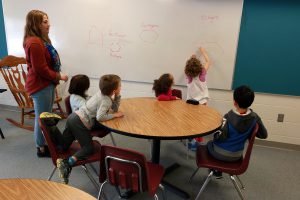By JESSICA KOPP
The partnership between Hamline Elementary and Hamline University brings an abundance of opportunities for learning and connection. One of the newest additions to the partnership is the Math and Coding Literacy Project—a weekly program serving approximately 30 students, grades K-5, with lessons designed by Hamline University faculty and taught by Hamline University students.
After budget cuts meant the loss of Hamline Elementary’s Gifted & Talented specialist at the end of last year; Assistant Professor of Mathematics, Sayonita Ghosh-Hajra, saw an opportunity to fill that gap and in so doing, instill a love of math.
“I love to teach,” Ghosh-Hajra said, “and most of the time when I say I am a mathematics professor, I get comments like, ‘Math is hard’ or ‘I’m not good at it.’ The only way that belief can be changed is through showing children that math is fun, that math is everywhere, and that whatever we do, we need math.”
 Photo left: A Hamline University student helps a group of kindergarteners to understand shapes. (Photo provided)
Photo left: A Hamline University student helps a group of kindergarteners to understand shapes. (Photo provided)
The project expanded after a conversation between colleagues. Assistant Professor of English, Jen England, explains, “Professor Ghosh-Hajra and I were discussing the value of community-based learning projects. She mentioned her work with Math Connections, and I mentioned my work with girls’ technology camps. From there, a conversation about a collaborative project at Hamline just emerged.”
The program is divided into K-2 and 3-5 cohorts, each group meeting once a week for 45 minutes. The coding lessons are designed in a collaborative fashion, with England leading a group of university student volunteers through the process, “The coding volunteers and I met several times early in the semester to create an overall plan for our portion of the project,” England said. “Because there are no K-12 coding standards to ‘map’ our lessons onto, we decided to focus on HTML and web development/design. For the volunteers, I think this has provided an important opportunity for thinking about the ways we develop literacies and the ways we communicate new topics to different audiences. For the kids, I think this has shown them they don’t have to be computer scientists to learn and create code and that reading, writing, and design are all important factors in coding.”
If you observe this program in progress, you’re going to see a lot of learning and a lot of wiggling. “We’re not going to be laying on the tables, okay?” says Olivia, a 19-year-old business management major, with a smile on her face as she organizes her group of five kindergarten students. They begin the lesson on shapes by identifying the names of shapes by their number of sides, up to ten, and then they are invited to draw shapes on the whiteboard with 14, 15, 16 sides. As one student draws, the rest of the group counts out the sides. They learn words like “vertices” and “edges” and say things like “an octagon is just a heart” and “that’s a funny shaped shape.” The kids laugh before turning to their own papers to draw the more familiar polygons, manipulatives at their fingertips for inspiration.
The classroom is characterized by collaborative learning, exuberant giggles, and Olivia’s patient, engaging, and encouraging nature. “Math isn’t everyone’s favorite,” Olivia says, “so I like the opportunity for hands-on learning in a small setting. It’s hard for them to sit still but I love working with these cuties!”
The rest of the K-2 group, eleven first and second graders, is divided among three university students and patient explanations, enthusiastic high-fives, and smiles are everywhere.
Andi Eckl, a first-year student, got involved in this project because she loves helping kids, “Math is fun to teach because when kids understand math, they have this sort of confidence in their intelligence. And that is an amazing thing to see.” The most rewarding part of her work in this program is when kids understand the lesson.
Because Eckl hopes to work with kids in the future, this opportunity has been particularly special, “It has confirmed all my aspirations and provided for a really fun time getting to know these kids. They have a lot of personalities, and it is cool to be able to connect with them where we can laugh together and talk about weekend activities—and also learn about math.”
The Hamline to Hamline Collaboration allows for innovation, growth, and inspired ideas and the professors responsible for this inspired idea see a bright future for the project.
Professor Ghosh-Hajra looks forward to finding grants that will expand the project to include more elementary students. England hopes to expand the curriculum and connect the kids’ HTML work to a website connected to The Snelling Connection, a writing and journalism program for Hamline Elementary students advised by Hamline University students.
Stay tuned to see what happens next.
Comments
No comments on this item Please log in to comment by clicking here